The Godfather trilogy, a cornerstone of American cinema, has long been celebrated for its compelling storytelling, intricate character development, and profound cultural impact. While the first two installments, directed by Francis Ford Coppola, are often heralded as masterpieces, the third entry, The Godfather Part III, has sparked considerable debate since its release in 1990. Critics and audiences alike have grappled with the film’s perceived shortcomings, questioning whether it stands as a worthy successor or a significant departure from the legacy of its predecessors. This article seeks to dissect the elements that have fueled this discourse, examining the narrative choices, thematic continuities, and cinematic execution of The Godfather Part III to determine if it truly represents the series’ biggest letdown or if it deserves reevaluation within the broader context of the trilogy.
Critical Analysis of The Godfather Part IIIs Narrative Structure
The narrative structure of *The Godfather Part III* has been a topic of debate among fans and critics alike. The film, released 16 years after its predecessor, attempts to encapsulate the weighty themes of legacy, redemption, and the inevitable passage of time. However, its execution often feels uneven, lacking the tight pacing and intricate plotting that defined the earlier installments. The narrative is split between Michael Corleone’s struggle for legitimacy and the rise of a new generation, yet the two threads often seem disjointed, failing to weave into a cohesive tapestry that drives the story forward with the same intensity as its predecessors.
- Character Development: While the film aims to provide closure for Michael’s arc, the introduction of new characters sometimes detracts from the depth of existing ones, creating a narrative imbalance.
- Subplots: The Vatican banking scandal and the rise of Vincent Mancini, although intriguing, occasionally feel underdeveloped, leading to a narrative that meanders rather than builds to a compelling climax.
Ultimately, the film’s narrative structure struggles under the weight of its own ambitions. The attempt to juxtapose personal redemption with grandiose political maneuverings results in a story that feels more like a series of loosely connected vignettes than a seamless continuation of the saga. This lack of narrative cohesion might be why many view it as a less satisfying conclusion to the otherwise critically acclaimed trilogy.

Evaluating Character Development and Performances in the Trilogys Conclusion
In examining the culmination of character arcs and performances in The Godfather Part III, one cannot ignore the evolving complexity of Michael Corleone. Al Pacino’s portrayal of Michael captures a man deeply entrenched in regret and seeking redemption, yet haunted by his past decisions. Pacino’s performance is nuanced, embodying a character whose ambition has transformed into a quest for forgiveness. While some critics argue that Michael’s character development in the final installment lacks the compelling gravitas of the earlier films, others appreciate the introspective depth that Pacino brings to a character grappling with the weight of his legacy.
- Connie Corleone (Talia Shire): Evolving from a background character to a pivotal figure, Connie’s transformation into a matriarch reflects a shift in family dynamics, showcasing Shire’s ability to navigate a more complex role.
- Vincent Mancini (Andy Garcia): Garcia’s fiery portrayal introduces a fresh energy, with Vincent’s character serving as a bridge between the old and new guard of the Corleone family. However, some feel his development is somewhat rushed, lacking the depth afforded to previous key characters.
- Mary Corleone (Sofia Coppola): The casting of Sofia Coppola has been a point of contention, with criticisms often focusing on her performance. While her portrayal is seen as a weaker link, it inadvertently adds a layer of vulnerability to the Corleone family’s narrative.

The Impact of Production Challenges on the Films Reception
The tumultuous production process of The Godfather Part III undeniably played a significant role in shaping its reception. Unlike its predecessors, this installment faced a myriad of challenges that hindered its potential. Director Francis Ford Coppola grappled with tight deadlines and a reduced budget, which led to compromises in casting and script development. Initially, Winona Ryder was cast as Mary Corleone, but her withdrawal at the last minute forced Coppola to cast his daughter, Sofia Coppola, in the pivotal role. This decision sparked widespread criticism and significantly impacted the film’s reception.
- Budget Constraints: The film was produced with a budget significantly lower than that of its predecessors, limiting creative freedom.
- Casting Issues: Last-minute changes in casting decisions disrupted the film’s cohesion and sparked audience discontent.
- Time Pressure: A rushed production timeline led to a script that many felt was underdeveloped compared to the first two films.
These production challenges contributed to a final product that, while not devoid of merit, struggled to live up to the monumental expectations set by its iconic predecessors. As a result, the film was often labeled as the series’ biggest letdown, not necessarily due to its narrative or cinematic quality, but largely because of the unavoidable compromises that were made during its creation.

Recommendations for Viewing The Godfather Part III in Context
To appreciate The Godfather Part III within the larger tapestry of the trilogy, it’s essential to approach it with an understanding of its narrative and thematic ambitions. Here are some key recommendations:
- Consider the Historical Context: Released in 1990, 16 years after the second installment, the film reflects a changing world and the aging of its characters. Recognizing the shifts in cultural and political landscapes can provide a deeper understanding of its story arcs.
- Explore the Character Development: Focus on the evolution of Michael Corleone. His journey from a reluctant leader to a haunted, regretful figure offers a poignant conclusion to his character arc.
- Analyze the Themes of Redemption and Legacy: These are central to the narrative. By exploring how these themes are intertwined with the consequences of past actions, viewers can appreciate the film’s attempt to tie together loose ends from the previous installments.
- Reflect on the Film’s Ambitions: Though it might not achieve the same acclaim as its predecessors, understanding the film’s ambition to conclude a complex saga can provide a richer viewing experience.
By adopting this contextual lens, viewers can uncover layers of meaning that might otherwise be overshadowed by the film’s initial reception.
